 |


Okinawa Trip 2005 
Page 2
|
|
Monday July 4
After breakfast, Joe B. and I took Lorie to the airport since she could only stay a week with us. She was very nervous about flying by herself home but we talked her through the itinerary, custom stops and so on. After seeing Lorie on the plane, Joe took me to the Seaman’s club at Naha’s port. After lunch, he took me to meet Izumi Hisashi Sensei, 6th dan, who was shibu-cho of the Koza Butokukan. Izumi Sensei owns the White River Photo Studio on Chuo Park Avenue near BC street in Koza and his wife owns the hair salon in the same building. We talked for a long time about karate and although he was very friendly, he seemed quite hesitant that Gibu Sensei would accept us. He invited us to come to his dojo on Wednesday since the hombu was closed on that day. We said goodbye and I headed back to the hotel to get some rest before we trained at the hombu that evening.
|
 |
 |
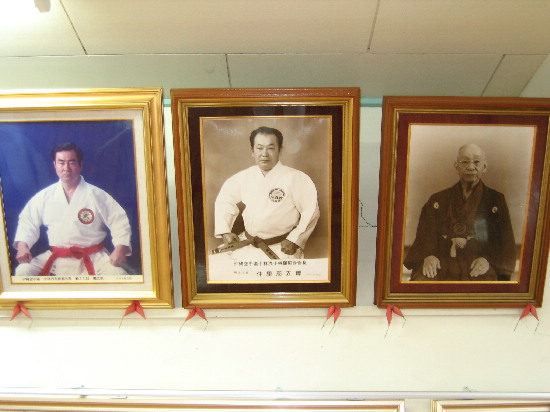 |
|
We arrived at the So-Hombu at 6:00 and as I walked up the stairs, I heard this pounding coming from inside the dojo. I peeked around the corner and saw Gibu Sensei punching the sunabukuro(square sand bag) with both hands. He was deep in concentration and had a rhythm going with the bag. I waited for him to finish and then apologized for being so early. He invited us all in and we quickly got changed. We all wore white belts on this trip and when he saw this , he asked me where my black belt was. I responded “gomibako ni”( in the trashcan). He said it was okay to wear it and again I refused. He then asked me why and I said that it said Shorinkan on it. He responded that he didn’t mind and I said “I mind” and bowed respectfully. I told him we were all beginners in his dojo and were happy to wear a white belt.
We took a group picture of our first official training and then presented him with gifts. He asked me to translate who each person was and what the gifts were. He also asked me to write everyone’s name in katakana so that he could remember each person by their name. This was very different from what I had seen in other Okinawan teachers that seemed to care more about the money they were getting from foreign dojos for training on the island-if you could call it that. I had been on two trips previously and every single visit to the dojo involved doing nothing but starting class with kihon kata,, ending with gojushiho and then going home. Gibu Sensei asked for no money for our training, wanted to know something personal about each person’s life and family and trained us personally. This was the Okinawan Sensei that I had dreamed of and the training that we all needed.
|
 |
| What was also amazing was that Gibu Sensei led all of the warm-ups, stretches and content. We warmed up with Dantai Tsuki/keri which is a drill of countless techniques to test spirit. It starts with 100 knee kicks, 100 shuto uchi, 20 side kicks each leg, 20 front snap kicks, and then endless combinations in shiko dachi. To humble us, he lined kids up in front of us as we were trying to keep from dying right there on the floor. They then had free time where members worked on kata or techniques on the bags. Gibu Sensei ended class and we crawled into the van in pain. We stopped by an A&W restaurant for dinner and then returned to the hotel to pass out. |
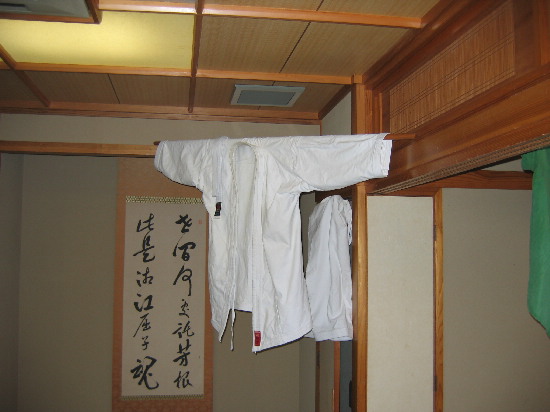 |
|
Tuesday July 5
We all took our time getting up today. Dave was really nice and took our gi’s up to do laundry while some of us remain horizontal on the mats. We were all very tired and very sore and decided to take it easy today. We walked around Gate 2 Street and found a nice little restaurant to have lunch. After returning to the hotel, we ended up taking a nap for about 4 hours-longer than we planned but I guess we needed it.
|
 |
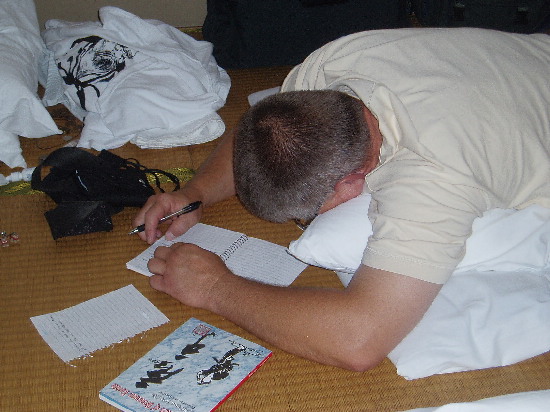 |
 |
|
We packed up and headed to the Hombu dojo. Hanshi let us in and after we were changed into our dogi, he explained all of the pictures and certificates hanging in the dojo. It was interesting to see the history of the Butokukan dojo and those who had trained with him. For instance, Gibo Giyu, 9th dan/Hanshi in Shorinkan was a student of Gibu Sensei and is present in the many group pictures in the dojo. Sensei led us in all of the warm-ups and stretching and then it was time for kumite. The kids did iri-kumi together and then with Makoto Gibu Sensei. Most of us sparred with each other and I got the opportunity to spar with Makoto Gibu Sensei. This was a very rewarding experience as he was a master technician and it was a good exchange-although he could of killed me at any moment. I was one of the most enjoyable kumite bouts I can ever remember.
|
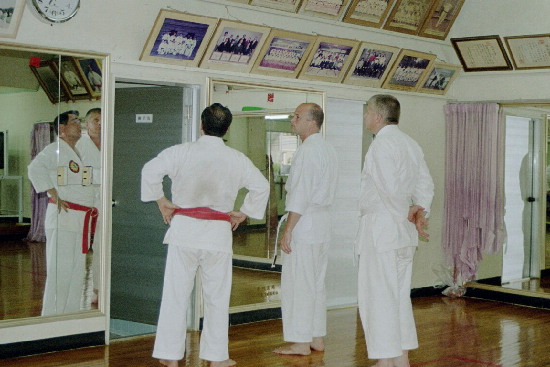 |
| After class, Gibu Sensei , Makoto Gibu and I went out to dinner to have another meeting at a restaurant nearby. It was a good discussion about membership and his expectations of me. Makoto Gibu Sensei, especially, was very specific about expectations as he is very protective of his father and the association. He didn’t have to worry as this was a privilege of a lifetime for any traditional karateka and I was grateful for this opportunity. No politics, no monetary greed-only traditional training from one of the most famous karateka to ever come out of the Shorinkan. Our conversation then turn to our personal lives and it was nice to learn more about each other outside of the dojo. |
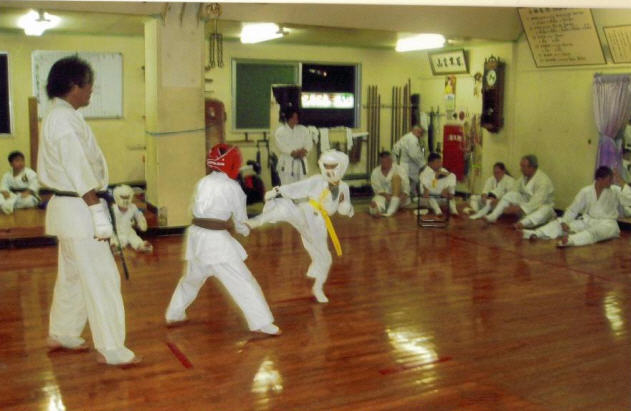 |
|
I returned to the hotel and had the guys meet me at Sushi Yoshi to tell them the good news and the information from dinner. We had a quick meal and then headed back to call it a night. (almost)
Our room phone rang at 3:30 in the morning and I grabbed it, not knowing what time it was or what was going on. The front desk clerk was trying to explain something to me and then I heard a familiar voice on the end say “John Spence, this is Neil, I am coming up.” It was my good friend Neil Stolsmark, who had taken a taxi from Naha to our hotel with a student of his named Jason and my friend Carel vd Westhuizen from South Africa. They all came to Okinawa with Pat Haley to train at Nakazato Sensei’s dojo and there was a large group from the US and South Africa. They found the patio and were in rare form. It was great to see Neil and Carel and we all crawled out of bed while Neil sent Jason to find as much beer as possible out of the vending machines. Stolsmark Sensei is one of the funniest individuals that I have ever met and we hooted and roared on our porch until 5:30 when they decided to take a taxi back to Naha.
|
|
|
Wednesday July 6
We all nursed our Stolsmark hangover by sleeping in and getting up to have a casual lunch. We met Takamiyagi Sensei at his dojo at 3 because he had arranged an appointment for us at Hokama Tetsuhiro’s Okinawa Karate and Kobudo Museum in Nishihara. When we were with the Shorinkan, we were not allowed to go to see this museum while we were on Okinawa, as were also not allowed to go see other people’s dojos(even to just take pictures) so this was an opportunity that we were very excited about.
|
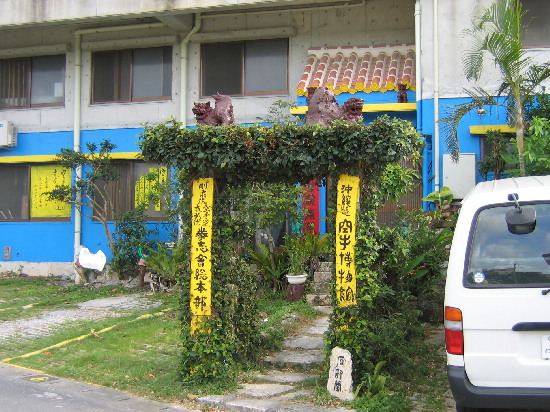 |
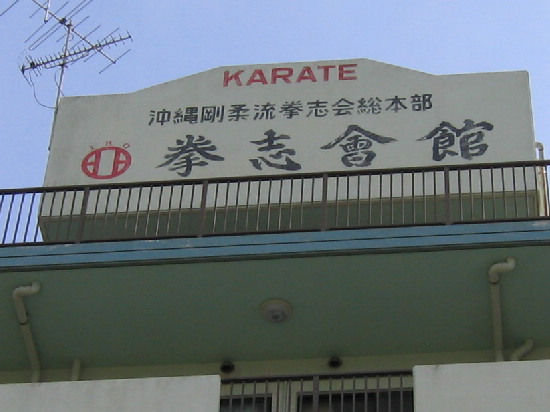 |
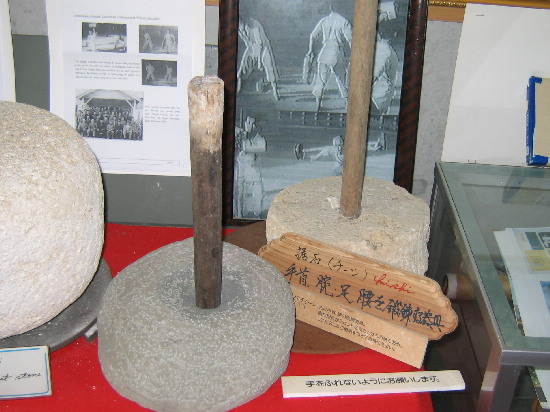 |
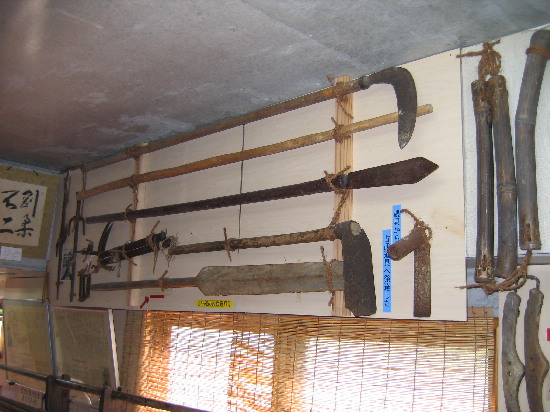 |
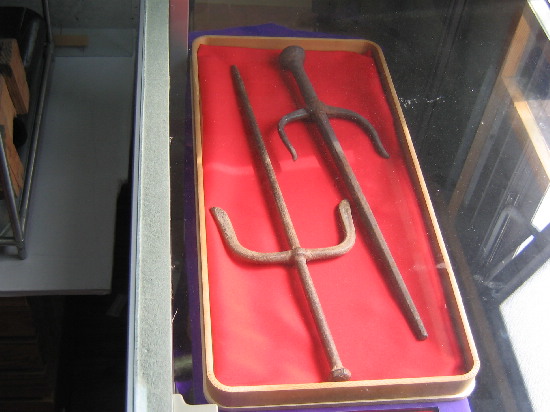 |
| We were greeted by Hokama Sensei who instantly was very approachable and friendly. He had an infectious, boy-like enthusiasm and was in constant motion as he would explain every aspect of the museum and pictures. We saw some amazing artifacts involving hojo undo, kobudo and history and drooled over the things that you just don’t see in history books. We each bought a copy of his new book and he personally brushed the inside cover of the book with a kanji/saying of our choice.
I glanced down next to his desk and saw a number of wooden kanban with his calligraphy on them. When I asked him about them, he said that they were for sale and would could any that we would like-FOR TEN BUCKS!!! My jaw hit the floor and we immediately started to go through them until Takamiyagi Sensei stopped us on one beautiful piece and said that it was the one that we should get and hang at the dojo. He said, “this best suits you and your students.” Hokama had brushed “ichi go, ichi ee” which means that treat every encounter with each other as special. Very similar to icharaba chode in uchinaguchi (Okinawa language) which means once we meet we will always be family. We were very excited to have a Hokama piece but also to have had an eighth dan personally pick it out for us.
|
 |
|
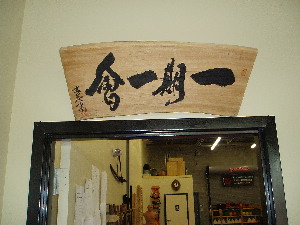 |
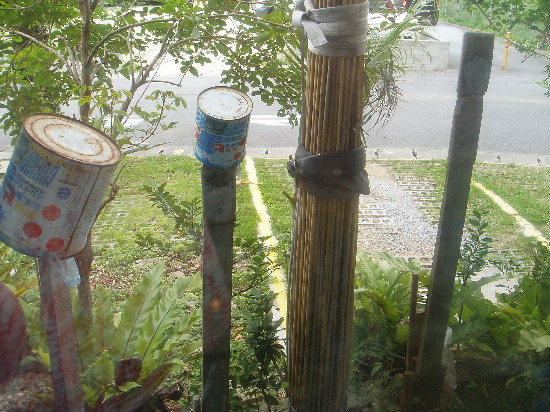 |
 |
| The guys bought a couple for themselves and then we proceeded downstairs for a surprise. Hokama Sensei began an impromptu, hour-long seminar on karate and kobudo. It was amazing and this unbridled enthusiasm kept us all watching like little kids. He started with a demonstration and explanation of all of the hojo undo equipment and then talked about “rhythms “ of hitting the makiwara, something that he loves a great deal when looking at his hands. He moved next to karate and the misconceptions of bunkai based upon the “appearance” of the kata as well as the incorrect interpretations that practitioners of sport karate have. Dave was a willing participant as he got the honor of being Hokama Sensei’s uke but we were all very glad it wasn’t us. Hokama Sensei’s oyo was very devastating and based on Dave’s expressions, very painful. Hokama Sensei gave us a demonstration of Mura-Kobudo(village kobudo) and told us that he was earnestly researching the traditions of the Southern part of Okinawa and the outer islands. He showed some very effective and frightening techniques with the bo that were all based upon surprise and appearing innocuous. He demonstrated some interesting locking techniques using a tan-bo(short stick) on Dave and again, we were very thankful that Dave volunteered. |
 |
 |
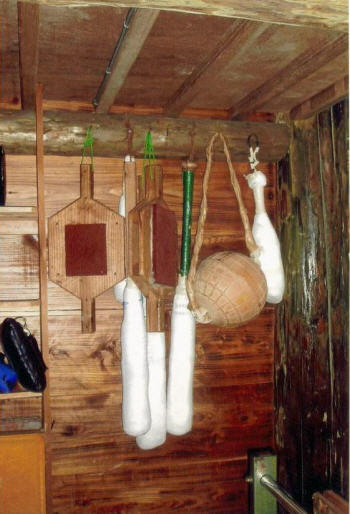 |
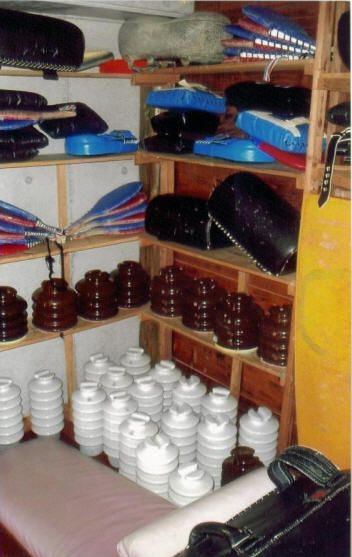 |
 |
 |
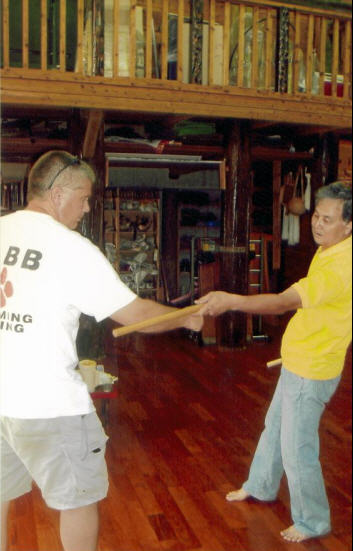 |
| We thanked Hokama Sensei at the end for an amazing experience and he added that he had a great deal of respect for Gibu Sensei and that we were very fortunate to have been accepted by him as students. |
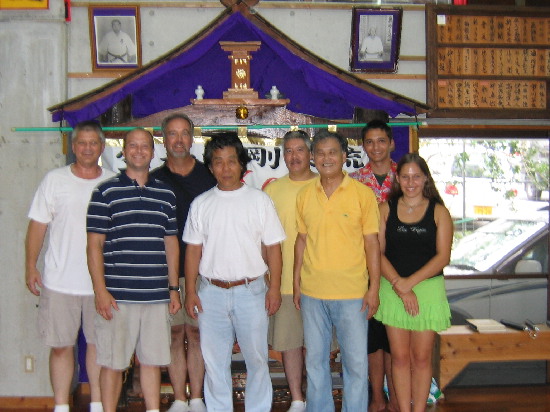 |
| We returned to Koza to prepare for our training session with Izumi Sensei at the Koza Butokukan. It took us about 15-20 minutes to walk from our hotel to Izumi Sensei’s dojo on the back streets of Chuo Park Avenue. As we climbed the stairs of his home/dojo, we rounded a corner and then were faced with one of the most beautiful dojos ever. I couldn’t believe what I was looking at as we bowed into the dojo and were greeted by Izumi Sensei. The dojo had a waiting area for guests, open dojo floor, a back area with weight benches/makiwara, shinbags, male and female changing rooms, shower, kitchenette and male and female bathrooms. The dojo was a museum of historical pictures of Shorin-ryu as a whole but also of Gibu Sensei’s Shorinkan and Butokukan history. Izumi Sensei has been one of Gibu Sensei’s students from the old days in the Shorinkan and talks of him like a father. It was kumite night for the Koza dojo(their specialty) and the kids were pounding away at each other and Izumi Sensei and his assistant. I did kumite with his assistant, who was one of the tallest Okinawans we had ever met. Typical iri-kumi and he kept punching me in the back of the shoulders with a “knock knock” sort of punch to get me try to get me to drop my guard. After kumite, we performed kata together and we watch his kids practice pinan nidan for an upcoming team kata tournament. |
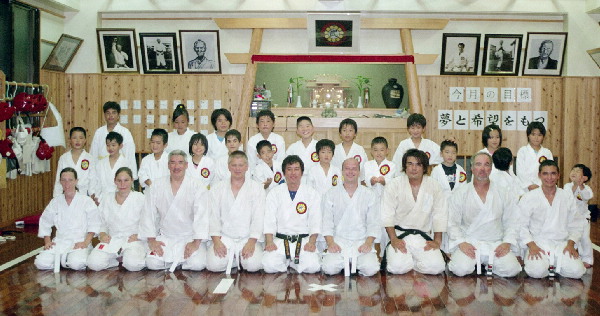 |
| After class, we talked with Izumi Sensei and one of his dojo parents and then left for the hotel so that we could treat Izumi Sensei for dinner. We had a great time and one of my funniest memories of Izumi Sensei happened that evening. He ordered a huge whole tuna head that was lightly fried and he and I began to share the dish together, picking through the delicious cheek meat. He popped one of the eyeballs out and put it on my plate and said “Tabete kudasai(Please eat it). I took this as a possible challenge so I instantly popped it in my mouth and chased it with my Orion. Izumi Sensei’s eyes got really big and then he started laughing, saying in Japanese that he couldn’t believe I ate it. I responded that he told me to and he said “but I didn’t think you would do it.” To finish, I popped the other one out and offered it to him and he said “I never eat the stuff!” Our first of many funny Izumi Sensei moments |
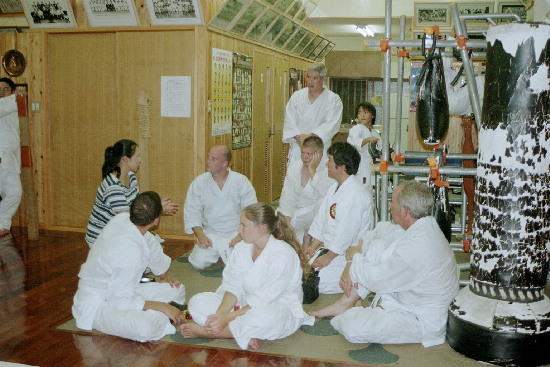 |
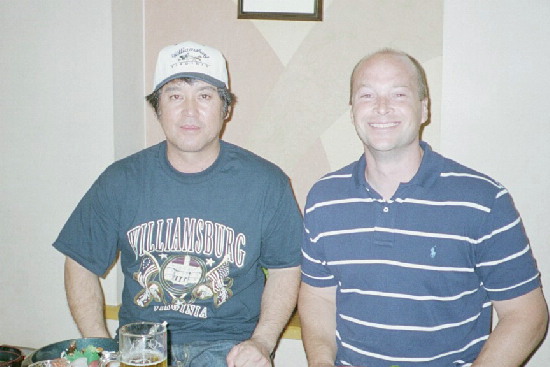 |
|
|
Thursday July 7
Today was a day to finish up any shopping that we might have to do and pick up orders a Shureido. We drove down to Shureido and after we were shopping for a bit, one of the attendants told me that Izumi Sensei had just called and asked that everyone in our group pick out a t-shirt as a gift from him! We waited around for Carel from South Africa and his group but they never showed so we headed down to Kokusai Dori to do some shopping. We met Joe Botulinski at Camp Foster around 11:30 and were able to eat lunch and send some things home via military mail. We returned to the hotel room and were lazy for most of the afternoon, catching up on entries in our diaries. I sewed my new Butokukan patch from Hanshi Gibu on my gi top and was excited to wear it in his dojo for the first time.
We arrived at the hombu dojo and in all of my excitement, I left my gi top at the hotel so I had to sprint back in the van to get it. We went through all of the Butokukan kobudo syllabus:3 sai, 1 tonfa, 3 bo, eku, and 2 nunchaku. Gibu Sensei told me that a lot of Nakazato Sensei’s kobudo were developed in the 70's and 80’s and that he never learned the “new” kata, in fact, we he began karate, there was only one bo kata and one sai kata in the Shorinkan.(Kinjo Kenpo, Hanshi/9th dan Shorinkan told me the same thing) We returned to Koza and to the usual place for dinner.
|
|
|
Friday July 8
I woke up and left for the airport to pick up my host family from Chiba Prefecture, the Kojimas, who I had stayed with when I spent a month in mainland Japan on a Fulbright Teacher Program in 2003. We had arranged to meet in Okinawa since their son had finished with High School entrance exams and they needed a long-overdue vacation. What better place than Okinawa! On my way there, I stopped by the Sunmarine hotel in Aja to pick up some things that Carel had brought me from South Africa and to hopefully see Pat Haley, but they had left already so I continued to the airport. I met the Kojimas and helped them put everything into van for the ride to Koza. They had not eaten so we stopped in Chatan at “Bikkuri Donkey”(surprised donkey) restaurant that specialized in something similar to Texas Chicken Fried Steak.
After checking in at the hotel, we caught up on each other’s lives and then we went back to our rooms for a nap(these were becoming quite common). We all left for the dojo for the final workout of the trip and I introduced the Kojimas to Hanshi Gibu.
|
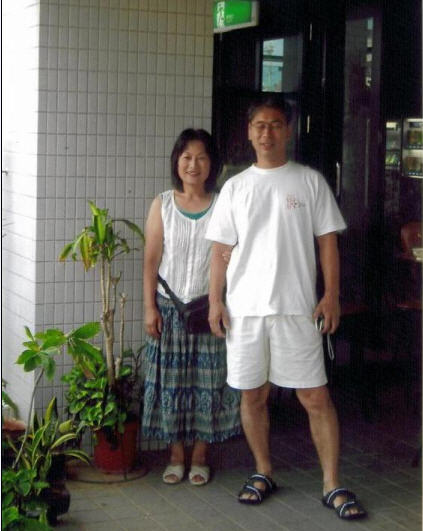 |
| We did the normal warm-ups and then went through all of the kata in the Butokukan syllabus. Gibu Sensei seemed happy that we had remembered all of the differences between his kata and the Shorinkan variations that were being taught in the US.
However, one of the frustrating things about going to the old Shorinkan camps was that the kata would change each year. Hand positions would change, new rhythms or stances were being added every time a class was led by a different instructor, and of course, ludicrous, personal explanations of bunkai from people that were never personally shown these from anyone on Okinawa. The common thing about kata that was repeated to was “we just got back from Okinawa and this is the way they are doing it now.”
|
 |
|
When Gibu Sensei was correcting our kata or kobudo kata, he would ask about a hand position or movement and then ask who taught us that. He would then look at me like something was terribly wrong. He remarked a number of times that he had practiced these kata since he was a teenager and Nakazato Sensei had NEVER changed them.(except for the high shuto hand position). He also said that he was still friends with his old Okinawan dojo mates in the Shorinkan and they did not practice the kata or kobudo the way people were being shown in the US. His observation was that people in the US were modifying kata for tournament competition and it was disgraceful that things were being altered from their original form.
We continued through the kata until Gibu Sensei was comfortable that we had a grasp on the improvements to our kata and that we had enough to work on until we saw him next. He was very specific in his charge of us to commit to memory the changes that needed to occur in the kata so that we would be preserving his heritage that he received from his teacher. He also did not want to overload us with too many corrections because we would not remember them all.
|
 |
| We left for the hotel, quickly changed and then took Gibu Sensei, Makoto Gibu, one of their students and the Kojimas out to dinner at Sushi Yoshi. Eiko san kept doing everything for every person present: pouring drinks, snapping her fingers at the waitress when she felt that she wasn’t being attentive enough, etc. We had a great meal with Gibu Sensei and he and Makoto let everyone at the table ask questions about them and karate. I had Joe sneak to the counter to pay for everyone’s dinner and Eiko San intercepted him and really let him have it for us trying to pay. She kept saying that WE were the guests in their country and have no business paying for anyone. We said good evening and saw Hanshi off. It was time for the usual patio party and Orion. |
 |
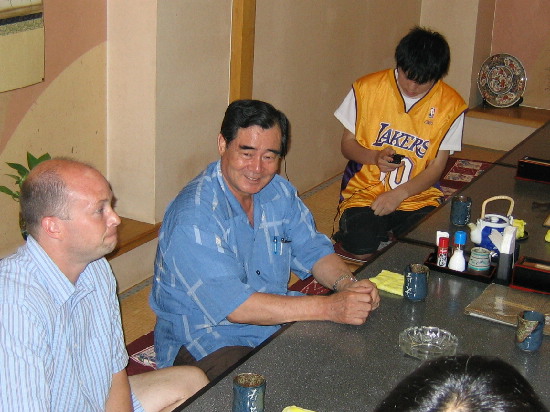 |
 |
 |
|
|
Saturday July 9
The Kojimas wanted to go to the beach and so we all packed up and headed for Sunset Beach since it was closest. It was a hazy summer day with a lot of wind and low visibility but a typical day where not-so-bright gaijiin will not worry about the sunblock and end up in a world of pain. I learned my lesson through someone else’s stupidity when we were in Okinawa in 2002. A person that was on the trip was warned by an Okinawa about the importance of sunblock, not suntan lotion at San San Beach. This person ignored him saying “I’m from California, I live in the sun.” Well by the next day, this person’s skin was coming off in layers, their tongue was swollen, their lips were swollen and peeling in layers and they could barely move. Dear readers, the Okinawa sun is unlike any place you will experience and it is dangerous. Over here in the states, they tell you that you should turn over every 20 minutes-over in Okinawa, it should be about every 8 minutes and with 50 sunblock.
|
|
| Anyway, being very comfortable as married, heterosexual men, we formed the Okinawa chain gang line of sunblock application. (We couldn’t find any beautiful , bikini-clad Coppertone girls to apply it for us) We had a nice morning on the sand and did a little swimming before continuing on the Hombu dojo to meet Gibu Sensei. |
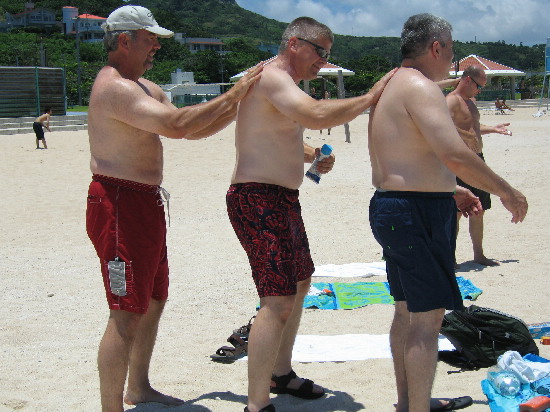 |
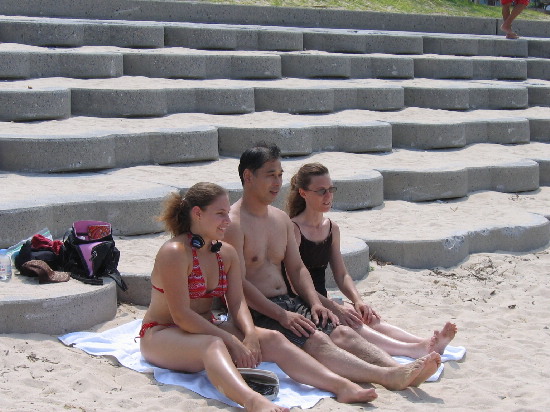 |
 |
| He was giving his employees a “thank you” party at San San beach and had invited us along to enjoy the day. His son in law, Katsuya san, tied a green handkerchief to his car antenna so in case we lost sight of him in traffic. We followed him to the beach and got to meet his employees who had already begun cooking food and serving drinks at one of the rented pavilions.I have never seen so much food and drink in my life and it was all incredible; scallops, sashimi, steak, pork, clams, cold Orion-you name it. All of the employees spoke of Gibu Sensei like a father and said that they had so much respect for him. They also said that he made them feel very valuable and appreciated the hard work they did. The employees began fun relay games and then an interesting drinking game involving beer and a salad bowl. Eiko san felt that she had to assist me in the contest and the 4 foot 4 lady grabbed the bowl from me and was the anchorperson! Hilarious. We all went snorkeling afterwards until Sensei came to get us and told us that he had to leave. It was a very abrupt and sad sort of ending as we felt that this was “goodbye” but it wasn’t as we were now his students and would be training as often as possible. |
 |
 |
|
|
|
 |
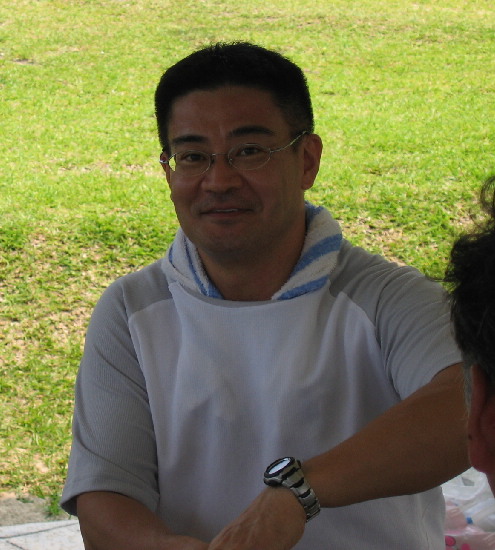 |
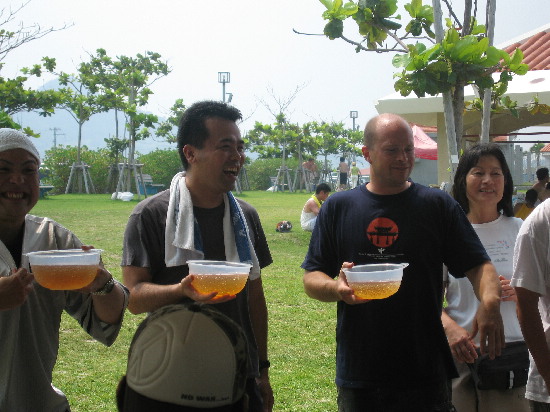 |
|
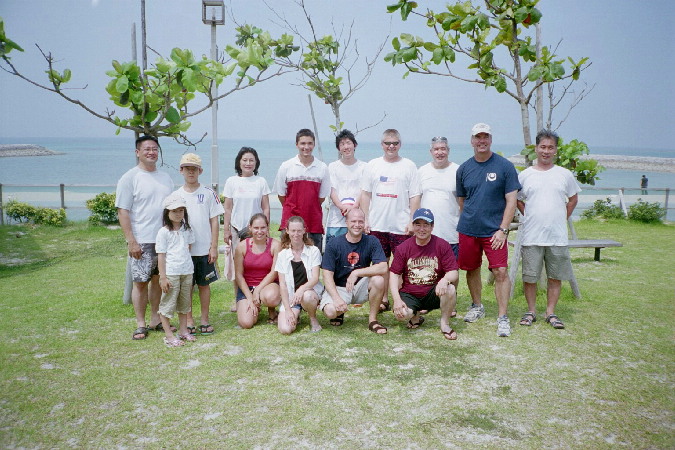 |
Last Day Beach Party
Left to Right(back row): Makoto Gibu, Hiroshi Gibu, Eiko Kojima, Joe Orthner, Tooru Kojima, Dave Williams, Joe Wilson, Tim Poland, Tetsuo Kojima
Left to right (front row) Ryoko Gibu, Justine Sweeney, Debbie Sewell, John Spence, Sokuichi Gibu Sensei
|
| Sunday July 10
We packed everything up and went down to the lobby to get ready for the airport. Izumi Sensei showed up with a bag of gifts for everyone and we chatted a bit before leaving for the airport. In true Okinawan kindness, Izumi Sensei waited on the street corner and waved until we were out of sight. Gibu Sensei and Makoto Gibu met us at the airport and the Kojimas tagged along even though they were staying another week on vacation. It was a very emotional goodbye as this was an amazing trip and a start of a new life for the dojo. We could not have been more fortunate to be accepted by Gibu Sensei and will never forget his kindness.
|
|
 |
 |
|
|
Contents Copyright © 2017 Shorin-Ryu Shorinkan Karate of Williamsburg
Click Here to Return to the Shorin-Ryu Shorinkan Karate Home Page
|
 |

